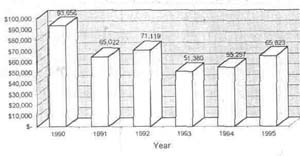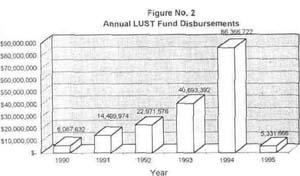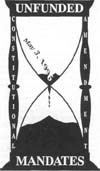|
LUST — Brownfields Update
By MICHAEL W. BAPPS, P.E. and RONALD R. DYE, C.P.G.
Governor Edgar Signs Lust, Brownfields Bills
The two most prominent environmental bills of the
1995 Illinois legislative session were recently signed into
law by Governor Jim Edgar. Senate Bill 721 provides
additional funding for underground tank cleanup and
House Bill 901 opens the door for risk-based environmental cleanups. Both bills deal with environmental
cleanups and, to some extent, both overlap one another.
And, each adds yet another layer of complication to an
already complex regulatory picture. Those affected by
the new statutes will find that there now exists a virtual
potpourri of cleanup options available for environmental remediation in Illinois. For those leaking underground storage tanks (LUSTs) reported prior to the
Illinois Pollution Control Board's September 15, 1994,
adoption of LUST rules (i.e., Part 732), tank owners
may now select from a menu of cleanup options that
can include the Illinois Environmental Protection
Agency's (IEPA) pre-rule standard, or Part 732 interim
standard (which is risk based), or risk-based guidelines
now under development by IEPA.
Two Masters
The Illinois LUST Fund, a state managed financial
vehicle for remediating leaking underground tanks, has
now run out of funds on two occasions. The first time
this occurred (1993), the legislature propped up the
Fund with $110 million generated through the sale of
bonds. By late 1994, the money had been spent and the
LUST Fund was in much the same shape that it had
been in the previous year. But, when the legislature was
unable to find additional funding in the Spring 1995
session, the Illinois program was placed at odds with
the federally mandated requirement for LUST financial assurance. With no relief in sight, USEPA reclaimed
the program, thereby imposing federal LUST rules on
Illinois tank owners to go along existing state LUST
statutes and regulations. At this writing, Illinois is subject to two sets of LUST regulations, and two sets of
LUST regulators.
Cleanup Wars
Because Illinois LUSTs are currently subject to joint
regulation by IEPA and its federal counterpart, you
may also throw into the aforementioned mix of cleanup
requirements and options, risk-based cleanup guidance
recently recommended by Region V of the United
States Environmental Protection Agency (USEPA). It
comes on the heels of yet another USEPA draft cleanup
guidance document, July 1994's Framework for Soil
Screening Levels (S.S.Ls). That document was nearly
coincident with publication of the Guide for Risk-Based Corrective Action (RBCA), earlier adopted as a
national standard by the highly respected American
Society for Testing and Materials. For those now insufficiently confused, consider also that for non-LUST
Brownfields, which in Illinois include pre-1974 LUST
incidents, the IEPA has been operating a voluntary
cleanup program since 1989, which program offers yet
another cleanup option. The Agency is now contemplating a proposed codification of pre-notice rules (as
Part 859) which, in early draft form, contain risk-based
cleanup options. A similar stand alone RBCA (pronounced Rebecca) Guidance Document has been circulated by IEPA for peer review, and is likely to be
proposed as a regulation that can jointly satisfy both
LUST and non-LUST (Brownfield) cleanup requirements.
Too Many Rules?
While the expense of environmental rulemaking
doubtless confuses both layman and non-layman alike,
the reader may take heart in that the moment may have
finally arrived in which nearly all of the partisans have
reached an accord. That there should be a risk-based
methodology for environmental cleanups is now a
generally accepted principle in Illinois. The current
regulatory confusion actually stems from a well intentioned patchwork of rulemaking and legislation,
spaced over several years, that has piled one partial
solution atop another, in the fashion of a tug-of-war.
This was born of a fundamental difference in philosophy which pitted IEPA's "old guard," and its rigid
single standard cleanup agenda, versus a national
movement by industry groups, as well as by USEPA,
aimed at customizing cleanups to fit circumstances and
need. In the end, the latter philosophy prevailed, due to
reoccurring shortfalls in cleanup money in the Illinois
LUST Fund. While recent legislation has fixed the
LUST funding crisis and made RBCA part of Illinois
statutes, the residual rules and statutes from the cleanup
wars remain on the books. As a result, the regulatory
landscape might now benefit less from the adoption of
new rules than from the repeal of the same old ones.
Senate Bill - 721 (LUST Funding)
SB-721, which initially dealt only with the subject of
convicted sex offenders, was used as a vehicle to secure
LUST funding in the fall veto session. With respect to
the latter purpose, it creates a new funding mechanism
that is expected to generate approximately $48 million
dollars per year during the next seven years. Funding
will be secured by imposition of a $60 per 7,500 gallon
tax on bulk fuel deliveries, to be passed on as a user fee.
It is estimated that this will equate to roughly 8-tenths of
a cent per gallon at the pump. Prior to adoption of
SB-721, LUST funding came from a 3-tenths of a cent
per gallon fuel tax, two-thirds of which is committed
for the long term repayment of the 1993 bond issue.
February 1996 / Illinois Municipal Review / Page 13
SB-721 is also intended to fix concerns raised by
USEPA that the Illinois LUST statutes and rules are less
stringent than federal requirements. That agency's
principal concern was that Illinois law allowed tank
owners to defer corrective action for LUST activities at
such times when the Illinois LUST Fund was depleted,
which generally describes much of the time of the
Fund's existence. Repeal of that provision was thought
necessary in order to clear the way for IEPA to regain
primacy over operation of the LUST program. Per
SB-721, new LUST regulations, that would correct various such matters, will need to be adopted by the Illinois
Pollution Control Board before January 1, 1997.
House Bill - 901 (Brownfields)
Approval of HB-901 came on the heels of the legislature's November 16,1995, acceptance of Governor Edgar's earlier amendatory veto of HB-544, the spring
session's "Brownfields" bill. The Edgar Administration
had disagreed with those provisions of HB-544 that
would have eliminated strict Joint and several liability
for all Illinois Brownfields. HB-901 served as a "trailer
bill" to the earlier vetoed legislation. It fixed the administration's concerns by providing for proportionate
shared liability for sites that enter the state Brownfields
program.
HB-901 creates Title XVII of the Illinois Environmental Protection Act, "Site Remediation Program,"
which establishes a quasi-privatization system for
Brownfields cleanup. In so doing, it identifies and defines roles for owner operators, cleanup contractors,
and oversight personnel. In addition, HB-901 introduces, as law, the concept of risk-based corrective action, and is explicit in setting forth that affected sites
must be evaluated using a three tiered "risk-based"
approach. Other HB-901 features are:
• HB-901 is not applicable to sites already regulated
under RCRA, CERCLA, or LUST rules or statutes. However, where applicable, such sites may
utilize risk-based corrective action procedures, to
the extent that they do not violate federal law and
regulations.
• HB-901 defines a Remediation Applicant (RA) as
the person performing the investigation or remediation.
• HB-901 defines the Review and Evaluation Licensed Professional Engineer (RELPE) as a licensed professional engineer contracted by an
RA, but who takes directions and work assignments from, and reports to, the IEPA.
• The goal of an RA is to obtain a "No Further
Action" (NFA) letter from the IEPA. The
Agency, with the assistance of the RELPE administers the site investigation and remediation programs.
• The required degree of site remediation can be
reduced through engineering, institutional, or legal controls such as restrict the current or future
land use, e.g., restrict residential use. However,
future changes in land use can be cause for the
retraction of an NFA.
• An RA is permitted to propose site specific
groundwater remediation objectives at levels that
exceed the IPCB's groundwater quality standards, i.e., an Agency approved variance.
• RAs receiving an NP'A must submit it to the applicable county recorder's office within 45 days of
receipt in order to make the NFA effective.
• HB-901 takes effect on July 1,1996. IEPA then has
until April 1,1997 to proposed applicable regulations to the IPCB, which is in turn required to
adopt final rules prior to January 1, 1998.
• A ten member Site Remediation Advisory Committee is created, appointed by the Governor,
comprised of seven members recommended by
industry, and three at large members appointed
by the Governor. The committee will provide
oversight of the statutes, rules, and operation and
activities thereunder, and make recommendations to the Governor, as appropriate.
Cleanup Standards
The traditional method for establishing standards in
the public health field, dating to at least the 1940s, has
been that of one size fits all. The sole recommended
health based drinking water standard for nitrates, for
example, has long been set at 10 milligrams of nitrates
(as nitrogen) per liter of water. Yet, nitrates represent
no known health threat to adults. The standard exists
only to protect infants, a relatively small portion of the
population. This is because infants are susceptible to
nitrate related methemoglobinemia (i.e., "blue baby"
syndrome). But, few would argue against enforcing this
standard in order to protect our most vulnerable. Such
standards are clearly appropriate. This is the traditional
model for setting health or aesthetic based standards
Page 14 / Illinois Municipal Review / February 1996
for air and water quality. First used in public health
agencies, the model was largely retained by successor
environmental agencies that formed in the 1970s and
1980s.
The general model for setting environmental standards is typically directed toward worst case scenarios
and applied "across the board." This is appropriate
when considering potable water or urban air quality.
And, certainly, from an administrative point of view, it
is far easier to enforce a single standard than one that
varies as to circumstances. But the health and aesthetic
based model begins to break down when it is applied to
environmental cleanups that do not directly relate to or
otherwise involve actual human exposure. In reference
to the earlier example, what should the soil cleanup
standard be set at for nitrates? There is no obvious
answer to this question. However, it is clear that to
cleanup soil nitrate levels to the 10 mg/1 drinking water
limit would certainly prevent the same soil from causing a nitrates exceedance in groundwater. Following
this line of reasoning, and independent of cost, a regulator can never err in approving a soil cleanup that is
taken to the lowest possible limit. This is the real story
behind the recent flurry of Illinois LUST and Brownfields legislation and rulemaking.
Edible Earth
In 1989, the Illinois legislature established a LUST
cleanup fund sustained by a motor fuel tax. When
created, the LUST fund was intended to pay for the
IEPA required cleanup of qualifying tank systems, subject to a $100,000 deductible. LUST cleanup standards
did not exist in the state at that time. But, in 1990, IEPA
established defacto soil cleanup standards for a set of
gasoline and fuel oil indicator compounds. For example, the cleanup objective for benzene, one of the most
common indicator compounds in gasoline, was set at 25
parts per billion (ppb). By way of analogy, a part per
billion is roughly equivalent to three seconds of time in
a century.
In 1991, IEPA tightened the earlier established soil
cleanup standards, lowering the cleanup requirement
for benzene, for example, from 25 ppb to 5 ppb. This is
a probable source of the often heard reference to "edible earth standards"; the drinking water standard for
benzene in Illinois is 5 ppb. At or about the same time
IEPA elevated the LUST cleanup standard, the legislature lowered the LUST fund deductible to $10,000 for
|
TABLE NO. 1
|
|
Illinois LUST Fund Disbursements
|
|
|
|
|
Gross Avg.
|
|
|
Funds
|
|
Dollars per
|
|
Year
|
Disbursed ($)
|
Claims Paid
|
Claim
|
|
1990
|
6,087,632
|
65
|
93,656
|
|
1991
|
14,499,974
|
223
|
65,022
|
|
1992
|
22,971,576
|
323
|
71,119
|
|
1993
|
40,693,392
|
792
|
51,380
|
|
1994
|
86,366,722
|
1,563
|
55,257
|
|
1995
|
5,331,666
|
81
|
65,823
|
|
Totals
|
175,950,962
|
3,047
|
57,746
|
|
most registered tank systems. The combination of these
two actions precipitated a frenzy of cleanup activity
that by year's end 1994 had tapped the LUST fund for
more than 170 million dollars.
Risk-Based Corrective Action
Cleanup expenditures in Illinois well exceed early
expectations of the rulemakers, as has the magnitude of
the problem. Illinois has more than 50,000 active and
registered underground storage tanks. And, from 1990
through year's end 1994, more than 12,000 LUST incidents (releases) were reported in the state. During the
same period, the Illinois LUST Fund distributed more
than 170 million dollars to cover fewer than 3000 claims,
with an average payout per claim of roughly $57,000.
The record of annual disbursements from the LUST
Fund is itemized in Table No. 1 and illustrated in Figure
No. 1. Companion Figure No. 2 shows the steady rise in
annual disbursements followed by the precipitous drop
in disbursements that inspired SB-721.
|
A substantial portion of the claims were for partial
or ongoing tank closures. Some tank cleanups, particularly those involving groundwater remediation, are expected to continue for many years, and at a cost that is
yet unknown. However, annual disbursements from
the LUST fund are expected to remain relatively constant for the next seven years, probably not exceeding
an average of $50 million per year. Long term cleanups
such as groundwater pump and treat systems that might
require more than seven years for completion do not
presently have assurance for funding beyond that window of time.
Given its enormous expense, its limited success in
achieving full closure on LUST incidents, and the absence of a foreseeable end point, the legislature read-
Figure No. 1
Illinois LUST Fund Disbursements ($) per claim

|

|
February 1996 / Illinois Municipal Review / Page 15
dressed the state's LUST program in 1993 by enacting
House Bill 300. The linch pin of that bill was its focus on
eliminating expensive investigations and cleanups for
LUST sites that posed little or no apparent risk to human health and the environment. The statute set forth
geologic settings and other conditions to classify LUST
sites as a High Priority, a Low Priority, or No Further
Action, and directed the IPCB to adopt regulations
from which IEPA could administer the system.
Interim Cleanup Standards
On September 15,1994, the IPCB adopted the Part
732 "LUST Rules" (35 111. Adm. Code 732, Regulation
of Petroleum - Leaking Underground Storage Tanks)
which rely on an interim soil cleanup standard. At the
same time, the Board created a sub-docket for purposes
of establishing permanent cleanup objectives. The
Board conducted a status hearing on the matter of permanent LUST cleanup objectives on October 12,1995.
But, given the state of the LUST Fund, the USEPA
takeover of the LUST program, and pending legislation, the Board postponed work on the sub-docket indefinitely.
LUSTs at the Grass Roots
Today's LUST laws and regulations date back to
1984, when Congress enacted amendments to the Resource Conservation and Recovery Act (RCRA). Home-owners and farmers are exempt from LUST regulations. However, the total number of schools, municipalities, and small business owners that must comply with
LUST laws well exceeds that of the major oil companies. So, unlike RCRA hazardous waste regulations,
which have had limited impact on most citizens, LUST
regulations hit at the grass roots level where they are felt
by local taxpayers and small businesses. This has probably made a difference in the outcome of LUST rule-making in Illinois. Whereas the hazardous waste lobby
might have had limited success in altering an environmental cleanup standard, stringent IEPA cleanup rules
applied at the local level probably aided in ushering in a
more economical risk-based cleanup approach. It also
helped to break up a major legislative log jam in the fall
veto session.
LUST Sites and Brownfields - The Future
Although rulemaking is incomplete, and while it
may take several years to pay down the accumulated
debt associated with old LUST projects, indications are
that LUST cleanups performed in the future will be
adequately financed. And, while pockets of resistance
doubtless remain, IEPA, as an organization, has come
to embrace the RBCA concept and has begun to approve risk-based cleanups. The Agency is soon expected to formally propose risk-based environmental
cleanup regulations that would apply to both LUST
and Brownfield corrective actions. The rules would
replace the interim risk-based cleanup formulae now
contained in the IPCB's Part 732 regulations. As earlier
alluded herein, most of those knowledgeable in the
subject will now agree that the accumulated statutes
and regulations that deal with LUSTs and Brownfields
tend to overlap, are, in some cases, obsolete, and under
any circumstance, could be safely consolidated and
simplified. It is unclear as to what group might step
forth to untangle the entanglements, although the Governor's Brownfields Advisory group is a best guess. •
 MAY 3, 1996—
MAY 3, 1996—
PASSAGE DEADLINE
Michael W. Rapps, P.E., is president of Rapps Engineering &
Applied Science, a Springfield based consulting firm. Mr. Rapps
drafted the interim soil cleanup objectives contained in the IPCB's
Part 732 LUST Regulations. Mr. Rapps is also a peer reviewer for
IEPA's proposed Brownfield/LUST RBCA cleanup standards. Ronald Dye, C.P.G. is a professional geologist with Rapps Engineering.
Mr. Dye has experience with the investigation and remediation of
more than 200 Illinois LUSTs.
Page 16 / Illinois Municipal Review / February 1996
|